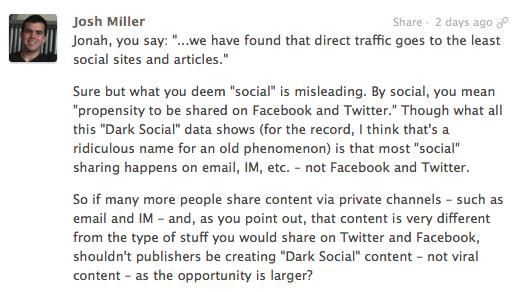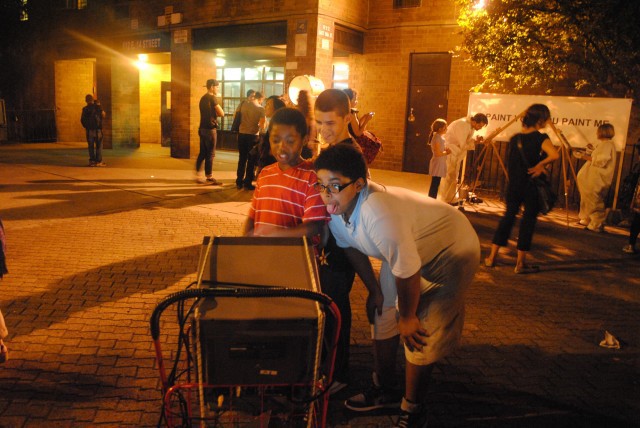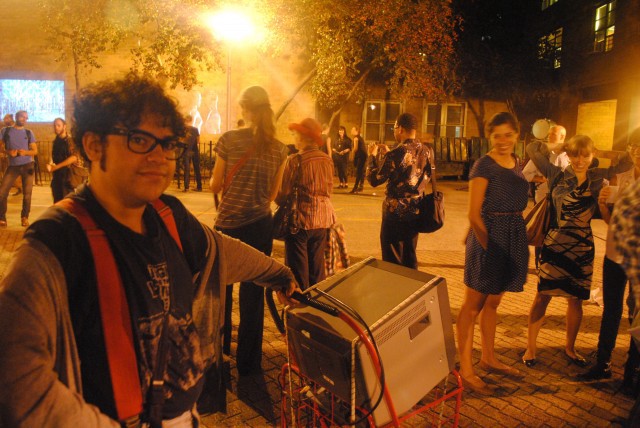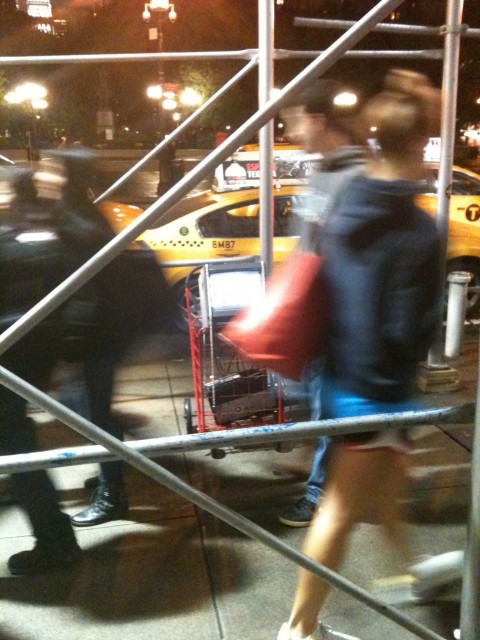Debating "Dark Social": Where the Rest of the Internet Is

This conversation pursuant to this recent piece on “Dark Social” (that is, sharing via IM or chat or email or IDK, IRC?) is interesting. It started with a look at traffic to the Atlantic, where they found that “all the social networks that you know” were really on just “about 43.5 percent of our social traffic. On the other, you have this previously unmeasured darknet that’s delivering 56.5 percent of people to individual stories. This is not a niche phenomenon! It’s more than 2.5x Facebook’s impact on the site.” What do you think? TELL US ON A SOCIAL NETWORK SOMEWHERE IN SPACE.
What Does How You Sleep Say About You?
“Do you sleep like a log? Or are you more of a yearner, a freefaller or a foetal? The position you choose while sleeping reveals a startling amount about your personality, according to body language expert Robert Phipps. Mr Phipps has identified four positions and says the foetal — most favoured by worriers — is by far the most common.”
— I guess it’s no dumber than astrology.
David Brooks' Argument In Favor Of Partisan Obstructionism

Here is the argument David Brooks makes in his op-ed, “A Sad Green Story,” in today’s Times: Government legislation to curb global warming, which he supports, has failed because because Al Gore supported it so strongly. It is the “highly partisan former vice president”’s fault, Brooks says, because after Gore’s movie An Inconvenient Truth came out in 2006, and Gore “became the global warming spokesman, no Republican could stand shoulder to shoulder with him and survive. Any slim chance of building a bipartisan national consensus was gone.” It is Gore’s fault, for being so highly partisan earlier in his career, that Republican congressman refuse, on partisan grounds, to support legislation that Gore supports and that David Brooks supports, too. Democrat Gore backed the poor Republicans into a corner by raising awareness of this issue that David Brooks thinks is important, by promoting good, important legislation like a carbon tax that David Brooks wishes had been able to pass. What were the poor Republican congressman supposed to do? Put aside partisan politics and support good important legislation after Gore had been so highly partisan earlier in his career? That would not be fair, Brooks argues, I guess along the lines of, “but he started it.” This is an argument that says that it is okay to block important legislation along partisan lines. It is only reasonable to expect a congressman to put his or her personal political survival over the good of the country. The responsibility for such a decision, for that kind of obstructionism, lies with the history of the person who has gotten out in front and supported good and important legislation. People who David Brooks thinks have tarnished themselves with partisan behavior should not support legislation that David Brooks agrees with. Because God forbid any politician “stand shoulder to shoulder” with someone whom he or she has disagreed with in the past. That is David Brooks’ argument today, and it makes him sad.
Woman Derisively Compared To Buzzfeed
“Early on in [Tina Brown’s Newsweek] tenure, there were covers for the Olsen sisters and Regis Philbin. Buzzfeed would have covered them, too, only in its ‘Nostalgia’ vertical, which, like Brown, is preoccupied with the 1990s.”
— Way harsh, Noreen Malone, way harsh.
Dong-Free Chatroulette Fails to Attract Users, Probably Due to Lack of Surprise Dong

“AppData, a service that collects data about sites and services that connect with Facebook, indicated that Airtime had just 400 users a day and 10,000 over the course of a month, but Mr. Parker and other executives at the company suggested those figures were off. Nielsen and comScore, two independent analytics firms, both said that traffic to Airtime was so small that it did not yet register on their charts.”
— Aggressive Facebook-harvesting startup Airtime is surely going to pivot to a dong-related market.
If We Have To Pay Off Gitmo Detainees, Can We Prosecute Ourselves For Funding Terrorism?

So let’s see, we convicted for war crimes all of seven people who have gone through Guantanamo. Now they’re all going to get off, thanks to a ruling by the U.S. Circuit Court of Appeals for the District of Columbia, on the grounds that none of the things they were doing were war crimes until after they did them. (Such as: being Osama bin Laden’s gardener.) But at least we got Omar Ahmed Khadr, because he actually murdered someone! Oh, but but he’s Canadian. So he’s up for parole next year. He’ll be just another friendly dude running a Tim Hortons a year from now.
Also haha, can’t wait till all these jerks sue the U.S. government for wrongful conviction and we have to PAY MONEY TO THEM. CAN YOU IMAGINE? *BLARGH*
But don’t worry, we’ve got five wackos more to prosecute and kill, thereby bringing balance to the world (???) and peace to the hearts of all (???).
The Plan For Space Hookers
“In our expedition to Mars, let our healthy young males take along some healthy young females to serve as their sexual partners. (Of course it would also help if they could operate a radio transmitter and take dictation.) These women would accompany them quite openly for this purpose. There would be no secrecy about this. There would be nothing dishonorable about their assignment. They would be women of the kind we ordinarily speak of as ‘nice girls.’”
— Don’t worry, this is from 1956. Nobody thinks this way now.
How New Yorkers Deal With Art in Public (Kids Love It; Rich People, Not So Much)
by Adam Burnett

Video maker Geraldo Mercado, diminutive in size, is a polarizing figure in the circles he travels. He’s sweet as pie, coquettish and flirty with everyone he meets — but never holds back his opinion, especially when he’s talking about art. “Absolutely everyone knows how to talk about aesthetics, but they don’t normally engage in that conversation. So, how do I get people to talk about this? Once you start presenting things to people, they’re actual able to speak about it and have a strong opinion and think about the media abstractly, the media they take in on a daily basis.”
Geraldo is a Puerto Rican-born, Boston-raised, Brooklyn-based artist — a biography of hyphens. You can see him nearly every week break a TV or down half a dozen beers at galleries and performance spaces in Bushwick (the drinking is a feature of his performance “because people think it’s art,” he told me). His latest work, “The Kewpie Series,” was part of the Art in Odd Places festival, which takes place every October, confronting the public with art along 14th Street, from Ave. C to the Hudson River. This year’s theme — “Model” — led Geraldo to the Kewpie doll, the creepy iconic doll of our collective nightmare. “I found this Kewpie doll at a Goodwill near my house,” Mercado said. “I shot some test footage of it… and the camera picked up its face in the face recognition feature. The camera recognized this weird little doll as being human.”
Geraldo also happened to be listening to a lot of shortwave number stations at the time. From these disparate sources, Geraldo created a dozen short videos featuring the Kewpie doll in a variety of profound paranoia-inducing states — flying in space, on a Tumblr replicating itself over and over, imposed on the faces of YouTube starlets in bikinis — and scored by the bleeps and bloops of shortwave number stations. The video played on a VHS in a VCR connected to a TV and powered by a car battery, all nestled into a granny cart which Geraldo, with his trademark red suspenders, punk T-shirt and mad-scientist scare of hair, pushed along the streets without any detectable irony. His eyes searched the crowd, contemplating passers, anticipating the opportunity to talk to anyone about what they’re seeing.

I sat down with Geraldo and asked him about his experiences of creating and presenting public art in New York, such as, how did people on the street relate to his work? How did responses differ depending where he was in the city? And who stops and looks at public art (hint: not rich white men)?
What would you tell people when they came up to you and asked you about the installation, and they would say, you know, “What is this? What’s going on?”
The first thing people ask is not, “What it is?” The first thing people ask is, “Why?” People are curious as to why someone would go through the trouble of creating it, of bringing it into the public and standing around. And it’s very rare that people ask you the What first. Most people are like, “Oh man, why? Why?” When people ask me the “What” then I get excited.
When I was there, I noticed that every population of people will stop and engage, from every walk of life, except one: rich, old white men.
It’s really weird to see who stops and looks at these things and what their relationship to it ends up being. They’ll [rich, old white men] look at your artwork or installation or performance out of the corner of their eye quickly, and then move by. The other day I’m at the corner of Union Square and this guy comes up to the installation and he’s got his Nikon COOLPIX out and I’m like, “Okay. This guy’s gonna take a look at it.” And he stops and takes a picture of the yellow cab, turns around and takes a picture of the Barnes and Noble. And I’m like, “Dude! No! You’re doing New York wrong!”

Is this because of an attitude toward public art?
Public art occupies a weird space in New York. Usually the people who are engaged in it are the people who show up on purpose. The thing is, the people who go to galleries or performances in Brooklyn or wherever, they come on purpose, and they can interpret whatever happens as being art. But the art they’re seeing is designed to be transcendent on purpose. Art can only transcend on accident.
Would this be your case for public art?
When I did “The Kewpie Series” in Flatbush, I feel like that’s where I got the best response. People weren’t used to seeing a very bizarre piece of art happening around Newkirk Plaza. People were coming out of storefronts, stopping and looking, groups sitting and watching, talking to me about it. All of these people engaged in the what not the why. In Union Square everyone asks, “Why are you doing this?” But in Flatbush everyone asked, “What is this?” I also had a knife pulled on me. So it varies. But this is what you want to happen.
The island of Manhattan is so safe now. Tourists come here and rest their legs in Times Square, it doesn’t feel right. It seems half the population of my home state of Kansas lives in New York. I remember wanting to move to the city because I thought everyone else would be too scared to even visit. I wonder, as public safety has become the benchmark of the past two mayor’s administrations, have we lost something? Are public art and public safety exclusive?
It depends on the art and the actions. Artists always take a risk with their safety. The public is usually safe unless told otherwise.
Aside from being a video artist, you’ve been doing a significant amount of performance art in 2012. Is there a relationship between the two?
Performance is a very blue-collar thing. Think about it: all the performances happening right now. Someone smarter than me could make the connection that it’s because of the economy. Performance isn’t something that you have to buy or worry about selling. It’s art of the moment. It’s art of the now. In times of turmoil it shows up. So many of the dedicated performance artists are carpenters, art handlers — all blue-collar work. And they turn around and do this art. Their peers, the other blue-collar workers, think this is the most pretentious thing.
But I think about who goes to see these performances, well, they certainly aren’t rich. The rich go to the auction at Sotheby’s or to Christie’s. Or they go to theater: Broadway, off-Broadway, downtown theatre, whatever. They don’t like performance art.
They don’t even like theater.
Of course not! They like to show up and say, “Hey, I think I can see Philip Glass across from me.” And he’s probably asleep.
Related: Inside Marina Abramovic’s New Performance Museum
Adam Burnett’s writing has been published in Vice Magazine, Pif Journal, NYtheatre.com, and Three Rooms Press, among others. His new play, Nightmares, will premiere at The Brick in Brooklyn this January. Photos by Marlowe Holden.
